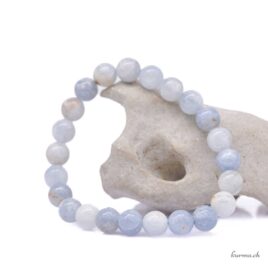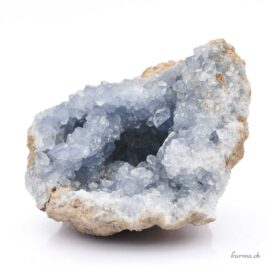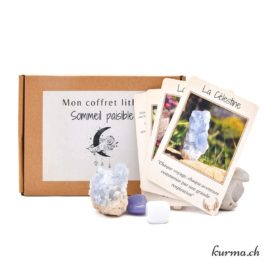La Célestine, Célestite or Coelestin
bracelets, geodes and rolled gemstones
Its pale blue hue and delicate and benevolent vibrations evoke the gentleness of heaven: nicknamed the Stone of Angels, Celestine is an ideal gem for creating a peaceful and serene atmosphere. In lithotherapy, its tender energy is ideal for quests for inner peace or for soothing babies and children.
What are the properties and benefits of Celestine in lithotherapy?
Tranquil and spiritual, Celestine's lithotherapy energy nurtures inner peace and connection to the higher planes of the spirit.
The origin of its symbols
Its known history dates back to antiquity, its spiritual virtues working towards an expanded perception of existence through the belief that the stone would be a fragment of heaven fallen to Earth, a gift from angels or born of their song to help humanity connect to the higher spheres.
For the Greeks and Romans, it was a protective amulet. It was a guide to a path of peace and purity.
Celestine was mainly used in powder and elixir form during Antiquity and the Middle Ages for magic and the manufacture of various remedies.
Contemporary beliefs associate it with the Pleiades constellation - in some esoteric traditions, the spiritual cradle of humanity.
La Célestine: a stone with many names
Its name comes from the Latin caelestis, meaning "celestial" or "from heaven". The form coelestis is also found in medieval texts, but caelestis is the classic Old Latin form.
Today, this stone is known by many different names, depending on the context - but it always refers to the same mineral, stronium sulfate:
- Coelestin, the most common, after Célestine or Célestite
- Cliftonite
- Colestine
- Dioxynite
- Eschwegite
- Angel stone
- Schutzite
- Sicilianite
- Strontiane sulfate
Therapeutic properties in lithotherapy
Because of its celestial nature, Celestine is a gentle, maternal and comforting stone.
Renowned for its calming and soothing effects, we place it in children's and babies' bedrooms to calm their anxieties and improve their sleep.
In lithotherapy, it acts on the nervous system, promoting sleep and helping to dispel anxiety. Linked to your breath and ribcage, this stone can be a great support in all uncomfortable or distressing situations, when your breathing becomes blocked or racing: agoraphobia, claustrophobia, hyperactivity, stress, fear of public speaking, nervous tics, etc.
Its company is welcome in times of sadness or worry. It releases salvific tears to get you through your sorrows, allowing you to breathe deeply in the present moment, in peace and with a new-found lightness.
It is a stone of great wisdom, opening the way to spirituality and higher dimensions. It can be used to enhance intuition and stimulate meditation. It can help clarify thoughts and release repressed emotions. It will be of great help to hypersensitive people seeking inner conciliation and to all those in search of peace of mind.
How do I use a Célestine?
- Keep a Célestine close to you in your daily life when you need comfort.
- In case of anxiety or sadness, if you feel a weight or knot in your lungs, place a Celestine on your ribcage, preferably a geode, and breathe deeply and slowly, visualizing the stone's energy penetrating your lungs.
- It can accompany a meditation or visualization session to amplify your perceptions.
Caution! Celestine contains strontium and should not be ingested or used as an elixir.
Where to place a Célestine?
- A Celestine in your home brings gentle, comforting and soothing energies. In geode form, Célestine brings a peaceful atmosphere to a place or home.
- You can place it in a child's, baby's or adult's bedroom to help with sleep.
- In a relaxation area, such as a salon or treatment room.
- On your desk, if you're stressed or if you tend to do things too quickly and botch your work.
What lithotherapy stones should a Celestine be associated with?
To amplify its benefits, you can combine a Celestine with complementary stones or crystals. For their energetic synergies, particularly in meditative practices or energy treatments:
- Amazonite or green Microcline can support the release of expression
- association withAngelite or Blue Anhydrite will promote a connection with the higher planes of the spirit
- the alliance with Quartz prase or Praseum will bring both emotional calm, anchoring in the present and relational harmony - helping to resolve conflicts by promoting self-confidence.
Purify your stone
Cleaning and resurfacing of La Célestine
She appreciates the Moon, fumigation, breath, running water, intention, singing bowl, shape waves, chimesAssociated astrological signs
Libra, Pisces, Gemini, Capricorn and CancerCommunication, clarity and spirituality
Chakra
5ᵉ, 6ᵉ and 7ᵉ chakras - Throat, 3ᵉ eye and CoronalExpression, clairvoyance, elevation, harmony and intuition
Element
AirThought, intuition, lightness
Mineralogy of Celestine
Celestine is a strontium sulfate (SrSO₄) containing traces of barium and calcium.
The stronium in the structure of the orthorhombic crystal explains its blue color, but it can also be colorless, white, yellow or red, depending on the impurities it contains.
It forms in marine sedimentary rocks and , more rarely, in hydrothermal seams, usually near gypsum, calcite or anhydrite. Its crystals appear in groups, geodes or fibrous aggregates.
It has a hardness of 3 to 3.5 on the Mohs scale - handle with care, as it can be easily scratched.
It is mainly found in Madagascar, the United States, Mexico and Iran.
In India, its powder is thrown into sacred fires to create an intense red flame - thanks to the strontium in its composition. Strontium, the main element in Celestine, was only identified in 1790. It may therefore be the source of the strontium used in fireworks, ceramic objects and certain metal alloys for various properties, the most notable being its refractory power in aerospace applications.
The term aqua aura, which has become very popular, does not refer to Celestine, as is often claimed, but to a Quartz dyed blue and sprayed with gold.
Lithotherapy
- Element(s) :
- Zodiac(s) :
- Libra, Cancer, Gemini, Pisces
- Purification :
- Singing bowl, Water, Fumigation, Moon, Form waves, Breath
- Caution(s):
- Do not ingest, Toxic elixir
- Physics :
- Lungs, Respiratory tract
- Emotional :
- Anxiety, Joie de vivre, Fear, Stress, Sadness, Balance
- Spiritual :
- Harmony, Meditation, Spirituality
- Disorder(s):
- Agoraphobia, Claustrophobia, Hyperactivity
Mineralogy
- Hardness :
- 3-3.5
- Moths scale:
- 3
- Strunz classification :
- Chromium sulfate
- Crystalline system :
- Orthorhombic
- Chemical element :
- Sr, S, O, Ba, Ca
- Line color :
- White
- Density :
- 3.97-4.0
- Cleavage :
- Total, friable
- Fracture:
- Irregular
- Transparency :
- Transparent to translucent
- Refringence :
- α=1,621-1,622, β=1,623-1,624, γ=1,630-1,632
- Birefringence :
- Δ=0.009-0.010; biaxial positive, 2V = 50°.
- Pleochroism :
- Colorless
- Fluorescence :
- Fluorescence, bluish or greenish-white luminescence, sometimes thermoluminescence, very often due to organic inclusions or impurities.
- Colors :
- Colorless, white to pale blue
- Magnetism :
- no
- Radioactivity :
- no
Continue your visit
*Please note! Some minerals may be toxic and must not be licked or ingested (as such or in the form of powder, elixir or stone water) or be in prolonged contact with the skin or mucous membranes.
*The information on the stones described here are general indications based on our research and experience, and are not exhaustive.
Reproduction in whole or in part of this content is prohibited. More info



